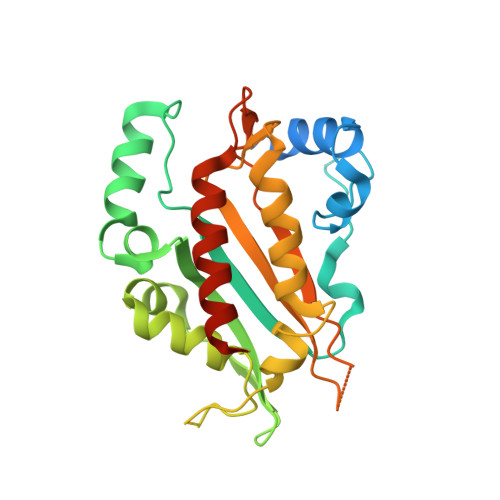Structural studies and protein engineering of inositol phosphate multikinase.
Endo-Streeter, S., Tsui, M.K., Odom, A.R., Block, J., York, J.D.(2012) J Biol Chem 287: 35360-35369
- PubMed: 22896696
- DOI: https://doi.org/10.1074/jbc.M112.365031
- Primary Citation of Related Structures:
4FRF - PubMed Abstract:
Inositol phosphates (IPs) regulate vital processes in eukaryotes, and their production downstream of phospholipase C activation is controlled through a network of evolutionarily conserved kinases and phosphatases. Inositol phosphate multikinase (IPMK, also called Ipk2 and Arg82) accounts for phosphorylation of IP(3) to IP(5), as well as production of several other IP molecules. Here, we report the structure of Arabidopsis thaliana IPMKα at 2.9 Å and find it is similar to the yeast homolog Ipk2, despite 17% sequence identity, as well as the active site architecture of human IP(3) 3-kinase. Structural comparison and substrate modeling were used to identify a putative basis for IPMK selectivity. To test this model, we re-engineered binding site residues predicted to have restricted substrate specificity. Using steady-state kinetics and in vivo metabolic labeling studies in modified yeast strains, we observed that K117W and K117W:K121W mutants exhibited nearly normal 6-kinase function but harbored significantly reduced 3-kinase activity. These mutants complemented conditional nutritional growth defects observed in ipmk null yeast and, remarkably, suppressed lethality observed in ipmk null flies. Our data are consistent with the hypothesis that IPMK 6-kinase activity and production of Ins(1,4,5,6)P(4) are critical for cellular signaling. Overall, our studies provide new insights into the structure and function of IPMK and utilize a synthetic biological approach to redesign inositol phosphate signaling pathways.
Organizational Affiliation:
Department of Pharmacology and Cancer Biology, and of Biochemistry, Howard Hughes Medical Institute, Duke University Medical Center, Durham, North Carolina 27710.















